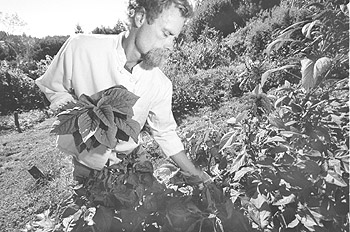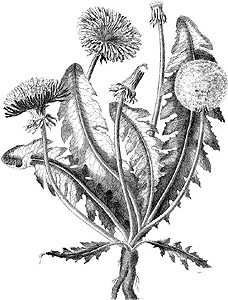![[Metroactive Dining]](/gifs/dining468.gif)
[ Dining Index | North Bay | Metroactive Central | Archives ]
Garden variety: Doug Gosling-- head gardener and exectutive chef of the Occidental Arts and Ecology Center--says weeds are good for the garden and the soul.
Something Wild
Nature's supermarket at your back door
By Marina Wolf
PICK ANY STRETCH of railroad track in any city of moderate size and you'll find it to be a short, bleak hike--10 minutes if you stay on the packed gravel and move at a brisk clip. But walk a little slower, take some time to really look at the plants peeking out from the edges of gravel and concrete. See those spiky flowered weeds, the sprawling clumps of what looks like grass? Some of it's good eatin', and it's all up for grabs.
Welcome to nature's supermarket, open 24 hours, self-service only.
Most of us have plucked a dusty berry from a brambly ditch, or pulled apart a head of clover for the bits of nectar within, or bitten into the sour, juicy stems of sorrel. Such furtive encounters tap into our collective heritage from the earliest days of humanity, when foraging was the way we survived. Now we pay top dollar for gourmet greens while wielding a wrathful hoe at the bounty that pops up in our front yard. Oblivious to the irony, we may even plant domesticated produce in the exact same location where we uprooted its wild cousin.
There are still a few people who maintain the original "weed" connection, in one way or another. In rural Sonoma County, the Occidental Arts and Ecology Center grounds its "weed policies" in very practical principles. "Weeds are good for the garden," states head gardener Doug Gosling firmly. Gosling oversees the two acres of bio- intensive beds, and the thriving "volunteers" ("I have a hard time with the definition of 'weed,' " he chuckles) are a crucial part of the garden's ecosystem. They keep the center's seed bank diverse, and they also make an excellent living mulch, holding down the soil and retaining nutrients. And, of course, they're good, dependable eating, as the menu-makers at the OAEC can attest.
"I'd say that well over 50 percent of the salads we eat, all year round, are made of so-called weeds," says Gosling.
And why shouldn't the weeds take center stage? These brazen green marauders are frequently more nutritious than any froufrou cultivated green stuff. Early-spring favorites--dandelion, lamb's-quarters, curled dock--have exceptionally high levels of vitamins A and C, which would explain why people of yore placed a great deal of faith in these greens as "spring tonics" after a long winter of poor provisions.
Even into the first part of this century, New York City opened Central Park each spring to the rummagings of Italian immigrants, who loved the tender young leaves of the radichielle (dandelion).
Nowadays you don't want to do that: most civic lawns suffer from a liberal hand with the herbicides. Fortunately, the urban landscape still abounds with foraging opportunities for those who are willing to stray from the beaten path. This has less to do with iconoclasm than with self-preservation: the beaten path has more cars and fewer buffers against them.
A road might be lined with wild food to feed an army, but without a curb, surface pollutants wash off that road right into the soil.
"There is no formula of feet away from the road to substitute for common sense," says John Kallas, a wild-foods consultant who has been leading expeditions in Portland, Ore., since 1978.
LIKE GOSLING, Kallas expresses a certain antipathy to the term "weed." "I get a much higher response when I call them 'wild gourmet garden vegetables,' " he says laughingly. At any rate, most of his classes and field trips extend beyond weeds into the underexplored realm of eating the neighbor's landscaping. "A lot of people plant things as ornamentals," says Kallas, "and they either don't know or don't want to bother with the edible aspects." Some varieties of roses, for example, drop their petals to reveal huge rose hips. And ornamental kale is quite edible, though you probably wouldn't want to harvest it from a gas station, its typical North American habitat.
Foraging in any neighborhood demands that you ask permission; not only is it courteous, but it gives you a chance to inquire--nonjudgmentally, of course--about past and present gardening practices. You won't always be able to find out, as in the case of abandoned sites and for-sale lots. But, as both experts say, unless you've been gardening your own land for years, there is never any way to know for sure what's in the soil.
So with all these concerns about safety, why bother to eat wild or semi-wild foods at all? Wouldn't it be safer and more convenient to go to the store?
Maybe. Or maybe not. As a forager, you will end up getting prickly things in your socks and biting into a lot of bitter leaves. Studying up on edible wild plants and making your first harvest in the company of an expert is a good idea, in any case. But reach beyond the thorns and you might find a a handful of greens or a hatful of blackberries more intensely flavored than any cultivated equivalent.
DOES IT FEEL STRANGE to step off the sidewalk to gather a few sweet petals from that clump of early spring violets on someone else's lawn? It should. That's the first step off the gastronomic "grid," the inexorable chain of supply and demand that gives us all access to the same plastic-wrapped packages of precleaned produce.
Go on. Get your feet wet. Take the muddy ditch less traveled. Find your own food.
[ North Bay | Metroactive Central | Archives ]
Copyright © Metro Publishing Inc. Maintained by Boulevards New Media.
![]()

Photograph by Michael Amsler
 See those spiky flowered weeds, the sprawling clumps of what looks like grass? Some of it's good eatin', and it's all up for grabs.
See those spiky flowered weeds, the sprawling clumps of what looks like grass? Some of it's good eatin', and it's all up for grabs.
From the October 4-10, 2001 issue of the Northern California Bohemian.